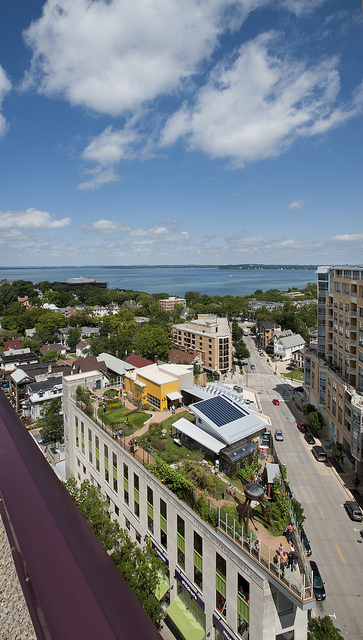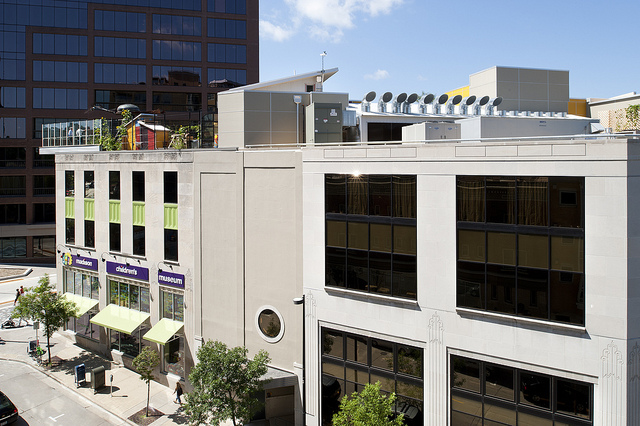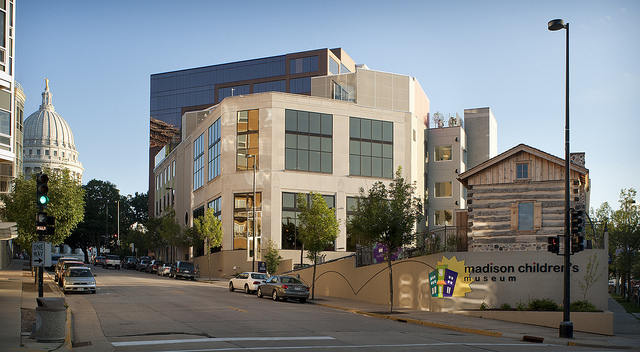Green Buildings Case Studies
Madison Children’s MuseumAddress: 100 N. Hamilton St, Madison, WI 53703
Phone number: 608-256-6445
Contact person: Brenda Baker
Email address: bbaker@madisonchildrensmuseum.org
Website: http://madisonchildrensmuseum.org/about/green-initiatives/
- Institutional Sustainability Mission
- Only Local Toolkit: http://www.greenexhibits.org/local/
- Sustainability Guidelines for Contractors
- Learning from Leopold and Seuss, (pdf) Brenda Baker (Madison Children's Museum), Guest Editor, Hand to Hand, volume 20, Spring 2006
- Seeing Green, (pdf) Jeremy Schoolfield, Fun World, The International Association of Amusement Parks & Attractions, June 2005
- "The Sustainable Museum: It's Not Easy Being Green," (pdf) Brenda Baker and John Robinson, Hand to Hand, volume 14, Winter 2000
Architect: Kubela Washatko Architects
Building Size: (square footage): 56,000 Sq. Ft.
Opening Date: April 2010
LEED Certification: Following LEED guidelines, although level yet to be determined
Project Description:
The museum's board of directors formally adopted an Institutional Sustainability Mission Statement in 2004, which now underlies all of the museum's work. In 2005, the Museum purchased a 56,000-square-foot historic flatiron building, a former Montgomery Ward's department store on Madison’s Capitol Square. The central location and ready access to public transportation were factors in initially choosing the site. Then, the decision to renovate the building rather than bulldozing and starting from scratch allowed us to conserve resources and minimize waste. Guided by listening sessions with more than 100 community members, MCM staff and a Wisconsin architect known for green building and historic renovation drew up plans that brought back the best of the building’s 1929 character by restoring the original front door and grand display windows.

Madison Children's Museum Aerial View
What Makes the Building “Green”?
The building is outfitted with mechanicals built for expansion and a heat recovery wheel. The Daikin system has heat pumps in the gallery ceilings paired with condensing units on the rooftop, where heat is extracted from or ejected into the air depending on the season. Also, in the winter, the heat recovery wheel extracts and retains heat from the air to be exhausted, reducing energy waste. The Museum also worked with Madison Gas & Electric to install solar panels on the rooftop; kids can monitor the amount of energy captured by the sun by watching to see whether the “solar-powered chicken” made from scrap metal lays an egg! Within the building, MCM's facilities team has been working to streamline energy output, by redesigning light fixtures, improving water efficiency in toilets and sinks, setting up lighting schedules and program run times, ensuring clean filters, greasing belts properly, and generally making sure the building runs as efficiently as possible. Many of these elements are good business practice that we would undertake anyway, even if they did not contribute to LEED certification. For example, we have been scrubbing the roof membrane to reduce heat island effects, cleaning exterior windows for maximum reflection, practicing erosion control to prevent leaching into storm drains, and ensuring good root systems for our plants. These elements help us look beyond the basic tasks to be proactive at all levels. Finally, our commitment to minimizing indoor air pollution also coincides with LEED's emphasis on the use of green seal cleaning products, with low toxicity and off-gassing.

Rooftop Mechanicals
Awards or honors:
- 2011 National Medal for Museum and Library Service from the Institute of Museum and Library Services
- 2011 MCM received the MetLife Foundation & Association of Children’s Museums’ Promising Practice Replication Award for its Only Local initiative
Only Local Initiative
The Only Local Initiative guided the new museum's building and operations by focusing on the local in everything we do: local people, local products, local knowledge, local culture, local artistic talent and local concerns. This focus allowed us to create what we considered to be the best possible museum that honors and respects children, the environment, and local culture, and is also owned, loved, and created by the community. Over 15,000 individuals—from local fabricators and contractors to elementary school students—contributed to the new museum, and only one of these came from out of state. The rest were all from Wisconsin, testifying to just how much the new space was grounded within the community. To give just a few examples, more than 13,000 local students made art in bottle caps, which were then embedded into mosaic columns by art students from Madison's alternative high school. Three hundred students created tiles for the museum's eight restrooms. Three classrooms conducted historical research for the Log Cabin exhibit. 700 students worked on a nanotechnology window for the Art Studio. Twelve advanced woodworking students at University of Wisconsin-Madison made benches for public seating. Countless community members donated objects or materials for Possible-opolis, an exhibit built with 95 percent reclaimed materials, including a three-seat hairdryer station, doll collections, benches, antique mannequins, historical artifacts and more than 15,000 board feet of sustainably harvested wood from local wood lots. As a result, the new building reflects community character, engenders community ownership, promotes local economic development, and inspires civic pride.
See the Only Local Toolkit to learn more: http://www.greenexhibits.org/local/

View with State Capitol
Distinguishing green features:
- Adaptive reuse of historic property on all major bus lines
- New HVAC makes use of natural ventilation
- Solar photovoltaic array and wind turbines
- Use of sustainable, salvaged or recycled materials throughout
- Green rooftop
- No VOC paints, finishes and glues used
- Local sources (from within Wisconsin or 350 mile radius of Madison) for labor and materials used as much as possible
- Rain catchment systems
- Low-flow toilets and fixtures
- Green exhibits throughout
- Bike racks to encourage bike commuting
Piece of advice for others regarding project:
Select an architect who has significant experience with green design, and whose philosophy is well matched with your institutional philosophy. The architect's experience with green design and sensitivity to your institutional goals and philosophy make all the difference. And importantly, choose people to work with who are team players, and you won't be overwhelmed if you can share the load.

